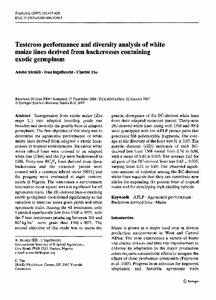| dc.contributor.author | Menkir, A. |
| dc.contributor.author | Ingelbrecht, I.L. |
| dc.contributor.author | The, C. |
| dc.date.accessioned | 2019-12-04T11:14:09Z |
| dc.date.available | 2019-12-04T11:14:09Z |
| dc.date.issued | 2007-06 |
| dc.identifier.citation | Menkir, A., Ingelbrecht, I. & The, C. (2007). Testcross performance and diversity analysis of white maize lines derived from backcrosses containing exotic germplasm. Euphytica, 155(3), 417-428. |
| dc.identifier.issn | 0014-2336 |
| dc.identifier.uri | https://hdl.handle.net/20.500.12478/2667 |
| dc.description.abstract | Introgression from exotic maize (Zea mays L.) into adapted breeding pools can broaden and diversify the genetic base of adapted germplasm. The first objective of this study was to determine the agronomic performance of white maize lines derived from adapted × exotic backcrosses in tropical environments. Six exotic white maize inbred lines were crossed to an adapted white line (1368) and the F1s were backcrossed to 1368. Forty-one BC1F4 lines derived from these backcrosses and the recurrent parent were crossed with a common inbred tester (9071) and the progeny were evaluated at eight environments in Nigeria. The testcrosses × environment interaction mean square was not significant for all agronomic traits. The BC-derived lines containing exotic germplasm contributed significantly to the variation in testcross mean grain yields and other agronomic traits. Among the 41 testcrosses, only 5 yielded significantly less than 1368 × 9071, with the 7 best testcrosses producing between 304 and 867 kg ha−1 more grain than 1368 × 9071. The second objective of this study was to assess the genetic divergence of the BC-derived white lines from their adapted recurrent parent. Thirty-nine BC-derived white lines along with 1368 and 9071 were genotyped with ten AFLP primer pairs that generated 506 polymorphic fragments. The average allelic diversity of the lines was 31 ± 0.07. The genetic distance (GD) estimates of each BC-derived line from 1368 varied from 0.76 to 0.84, with a mean of 0.80 ± 0.003. The average GD for all pairs of the BC-derived lines was 0.63 ± 0.005, varying from 0.31 to 0.89. The observed significant amount of variation among the BC-derived white lines suggests that they can contribute new alleles for expanding the genetic base of tropical maize and for developing high-yielding hybrids. |
| dc.format.extent | 417-428 |
| dc.language.iso | en |
| dc.subject | Maize |
| dc.subject | Backcross |
| dc.subject | Testcrosses |
| dc.subject | Exotic Germplasm |
| dc.subject | Agronomic Traits |
| dc.subject | White Maize |
| dc.title | Testcross performance and diversity analysis of white maize lines derived from backcrosses containing exotic germplasm |
| dc.type | Journal Article |
| dc.description.version | Peer Review |
| cg.contributor.affiliation | International Institute of Tropical Agriculture |
| cg.contributor.affiliation | Institute of Agricultural Research for Development, Cameroon |
| cg.coverage.region | Africa |
| cg.coverage.region | West Africa |
| cg.coverage.country | Nigeria |
| cg.creator.identifier | Abebe Menkir: 0000-0002-5907-9177 |
| cg.isijournal | ISI Journal |
| cg.authorship.types | CGIAR and developing country institute |
| cg.iitasubject | Agronomy |
| cg.iitasubject | Genetic Improvement |
| cg.iitasubject | Maize |
| cg.iitasubject | Plant Breeding |
| cg.iitasubject | Plant Genetic Resources |
| cg.journal | Euphytica |
| cg.howpublished | Formally Published |
| cg.accessibilitystatus | Limited Access |
| local.dspaceid | 93474 |
| cg.targetaudience | Scientists |
| cg.identifier.doi | https://dx.doi.org/10.1007/s10681-006-9344-8 |

